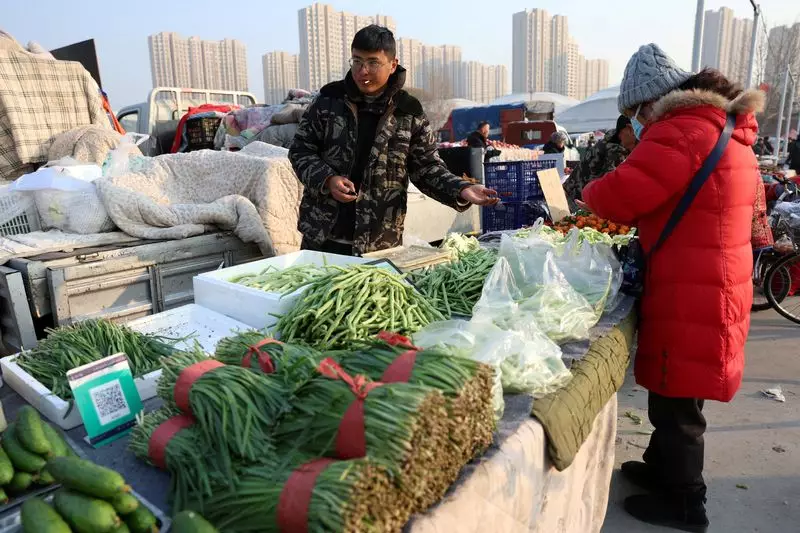The current economic landscape in China reveals a complex interplay of inflation metrics and producer price deflation that presents significant challenges for policymakers. As the world’s second-largest economy grapples with sluggish growth and persistent economic pressures, recent data from October highlights a slowdown in consumer price increases, accompanied by deeper deflation in producer prices. In a bid to stimulate demand, the Chinese government has enacted several fiscal measures, yet the effectiveness of these initiatives remains a topic of scrutiny among analysts.
Data released by the National Bureau of Statistics indicates that China’s consumer price index (CPI) rose by a mere 0.3% in October, marking the most modest increase in four months. This figure is below the anticipated 0.4% rise projected by economists and represents a decrease from September, which saw a 0.4% increase. Such slow growth in consumer prices raises concerns about the overall health of domestic demand, particularly in a period where economic stimulation is crucial.
Factors contributing to this subdued inflation include seasonal influences related to the Golden Week holiday in early October. Economic expert Bruce Pang emphasized that the benefits of stimulus measures instigated at the end of September had not yet manifested in a significant increase in domestic consumption. While core inflation—excluding volatile categories like food and fuel—did show a slight uptick to 0.2% from the previous month’s 0.1%, the overarching trend suggests a cautious consumer climate. These metrics underline an urgent need for effective policies that encourage spending and investment.
Amidst the slowing consumer inflation, producer prices have entered a troubling phase of deflation. In October, the producer price index saw a substantial year-on-year decline of 2.9%, exceeding previous falls and hitting the most significant plunge in nearly a year. Such deflationary trends are particularly concerning when associated with major industries like petroleum, natural gas extraction, and manufacturing, all critical sectors in China’s economy. The consistent decline in producer prices underscores the challenges faced by manufacturers who are unable to pass costs onto consumers, further adding stress to the economy.
The ramifications of producer price deflation extend beyond immediate financial metrics; they indicate a broader malaise in economic activity. With many businesses operating under tighter margins, the incentive to invest in expansion diminishes, potentially leading to stagnation in key growth areas. Consequently, the anxiety surrounding prolonged deflation raises profound questions about the future viability of various economic sectors.
Recent governmental interventions reflect an effort to reinvigorate the economy, yet they have not aligned with the expectations of investors. The announcement of a 10 trillion yuan ($1.4 trillion) stimulus package appears more directed toward alleviating burdens related to local government hidden debts rather than initiating broad-based economic growth. As finance officials indicate the potential for further measures—including tax incentives for the housing market—enthusiasm for significant fiscal stimuli has tempered.
Investors, who had anticipated comprehensive measures aimed at driving consumption and restoring economic vibrancy, are left grappling with mixed signals. The current initiatives lack the robust characteristics of a “fiscal bazooka” that would directly address the underlying issues of low consumer confidence and demand. Furthermore, the scenario raises questions about the timing of any forthcoming measures, particularly in light of upcoming political changes in the United States.
As analysts project subdued inflation rates and the likelihood of extended producer price declines, the consensus indicates a challenging landscape for China’s economic recovery. Forecasts predict a headline consumer inflation rate remaining low at approximately 0.8% into the next year, with a return to positive producer price growth not anticipated until late 2025.
In this context, policymakers may need to evolve their strategies from reactive adjustments to more proactive fiscal engagements to stimulate economic activity. Encouraging consumer spending through innovative policies, while also addressing the pressing concerns of the real estate sector, will be pivotal in charting a path forward.
China’s economic trajectory is filled with obstacles, as evidenced by the recent consumer price and producer price trends. While the government pursues various stimulus measures, their efficacy in invigorating economic sentiment remains in question. A coordinated effort to bolster consumer confidence and economic activity is essential to maneuver through these turbulent economic waters, making it imperative for authorities to remain vigilant and adaptable in their approach.

